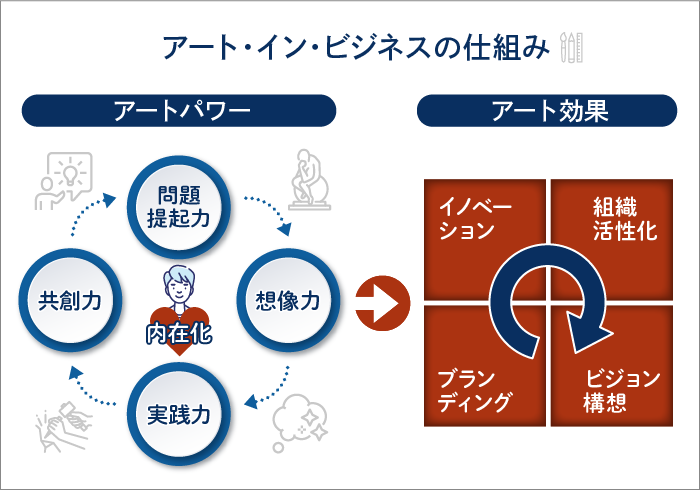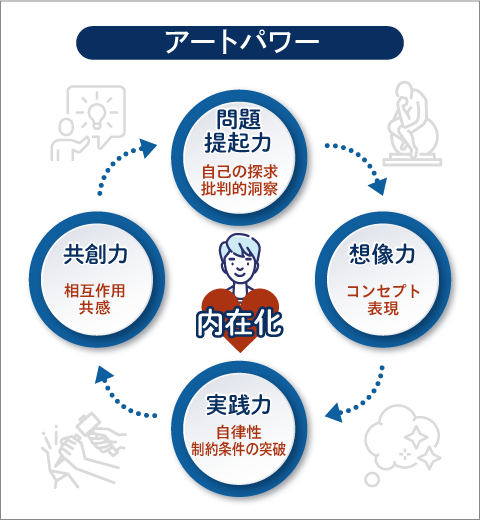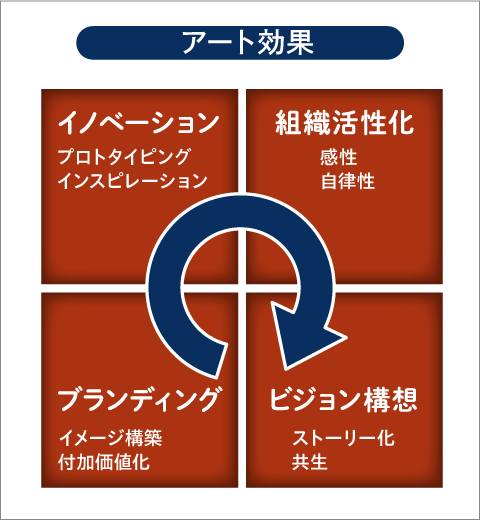Note: This website was automatically translated, so some terms or nuances may not be completely accurate.
How exactly does art benefit business?

Hiroyasu Wakabayashi
Dentsu Inc.
Hello, I'm Hiroyasu Wakabayashi, a member of Bijutsu Kōro (※1). I will be writing the first installment of our new series, "Art in Business: The Front Lines." Since publishing "Art in Business: The Power of Art That Works for Business " (Yuhikaku) in December 2019, we've seen significant reactions, including a reprint within a month of release. This has reaffirmed the high level of interest in the "Art x Business" field.
In this series, I will explore the cutting edge of Art in Business—topics that couldn't be fully covered in the book—and together with our readers, we will consider the theme: "Does art really work for business?" For this first installment, I will explain the fundamental concepts of "Art in Business."
(※1) Bijutsu Kiroku: An art unit supporting business creation that incorporates art power. Dedicated website.
Why is "Art" gaining attention now?
In recent years, phrases like "Future business needs art," "It's artwork, not client work," "After design thinking comes art thinking," "Art creates something from nothing," "Engage with art to refine your aesthetic sense," and "Business is just like art" have become increasingly common in the business world.
In this VUCA era—Volatility, Uncertainty, Complexity, Ambiguity—many business professionals are drawn to "art" as something mystical and possessing special power. At the same time, we often hear voices saying, "I understand art is wonderful, but how do I engage with it? How do I incorporate art into my own business?"
Among highly sensitive business professionals, the number of people wanting to do something with art is definitely increasing. There is a growing momentum to not just learn culture or ways of thinking from art, but to incorporate it and put it into practice.
What is "Art in Business"?
The diagram below schematizes how art can benefit business, based on influential case studies and quantitative research.

The central figure in this diagram is the business professional. Here, "business professional" encompasses not only top-level executives like CEOs, but also a broad range of professionals from middle to lower management, including project leaders, managers, and on-site planning staff. It illustrates how each individual business professional, through their personal experience of engaging with art, internalizes (※2) Art Power within themselves. This internalized power then gradually and broadly generates various effects within their business activities.
Now, let's explain the model's components—"art power" and "art effect"—in sequence.
(※2) Internalization: A social psychology term meaning "to incorporate" or "to make one's own."
What is Art Power?
Art Power refers to the source of vitality that enables artists to continue creating works—the driving force behind creation. We have extracted four types of Art Power: "Problem-Raising Power," "Imagination," "Practical Power," and "Co-Creation Power."

❶ "Problem-Raising Power"
The first Art Power is "Problem-Raising Power." The "power to question" can be considered the initial motivation for creating art. This encompasses "Self-Exploration" and "Critical Insight." Self-Exploration is the act of questioning one's own inner self—what one is, what one wants to do, and so on.
The other element is "critical insight." It involves challenging what has been taken for granted with a critical spirit. As a result, critical insight means continually questioning the premises of a phenomenon or theme, persistently asking fundamental questions like "What is ◯◯◯?"
❷ "Imagination"
The second Art Power is "Imagination." Among the four powers, this imagination is arguably the most fundamental force that makes art what it is. Imagination emerges through internal questioning and a sense of dissonance with society. Furthermore, "Imagination" has two types: one that simply reproduces past experiences, and another that reconstructs them according to a specific purpose. The latter is called "Creative Imagination" and serves as a crucial catalyst for generating expression.
Artist Yoko Ono has stated that her past experience of projecting thoughts onto the "sky" seen through gaps in the roof of her wartime evacuation home influenced her later creative activities, leading to her present-day art focused on the theme of peace.
❸ "Practical Ability"
The third element of art power is "Practical Ability." Artists create spontaneously according to their own will, not waiting for instructions from others. However, creative activity is solitary and demands a high degree of self-discipline. To achieve their goals, artists must align their actions with self-imposed rules.
While artists are granted freedom from constraints in their activities, they must simultaneously overcome various limitations. Even if they have something they wish to express, significant hurdles exist to bring their work into the world: the limits of their own technical skills, budgets for production, securing a creative environment, creating venues for presentation, and building personal networks. Artists overcome these constraints alone. This very breakthrough power becomes the vitality of their creation.
❹ "Co-creation Power"
The fourth element of Art Power is "Co-Creation Power." Once an artwork leaves the artist's hands, it is exposed to the eyes of viewers and critics, becoming a work open to society. Much of today's contemporary art challenges the art itself or established concepts, so it may be difficult to accept initially when it first appears. However, through the interaction between the artwork and the viewer, diverse interpretations emerge. Over time, aesthetic evaluations form, and eventually, the work transcends boundaries of era, region, and ethnicity, becoming something that resonates and is passed down to future generations as a work that can be understood and empathized with. In this way, the value of an artwork is created through co-creation with viewers across time and space.
We have now examined these four art powers. Artists, through the dual perspectives of questioning themselves and questioning society, present the products of their imagination to the world via their works from previously unseen angles. They practice art creation by overcoming constraints while believing in themselves, battling criticism and loneliness.
Then, over long years, through interaction with unseen people of later generations, they gain empathy, and the artwork is co-created as something open to society.
What is the Art Effect?
Regarding the effects of art in business, we have categorized them into "Branding," "Innovation," "Organizational Activation," and "Vision Formulation." As a premise, we cannot expect short-term effects like "doubling sales immediately by utilizing art." Starting from one of these four effects, we aim for the multifaceted effects of art to gradually ripple out over a long period of time.

❶ "Branding"
The first effect is "Branding." Artworks can be seen as symbolic entities packed with meaning and interpretation, lacking functional value as objects. They can truly be considered the ultimate brand. By leveraging the value inherent in such art, we can refresh the brand image of products or companies, build new "images," or enhance "added value" by imparting meaning that transcends the physical object.
❷ "Innovation"
The second effect of art is "Innovation." Art possesses the power to question assumptions and the imagination to materialize the intangible. Harnessing these abilities enables businesses to generate new "inspiration" or create groundbreaking "prototypes."
Innovation can be categorized as either incremental innovation, which is novel yet continuous, or disruptive innovation, which is groundbreaking yet discontinuous. The latter requires breaking free from existing frameworks. Especially in today's rapidly evolving environment, this latter type of innovation has become the mainstream.
Therefore, it is considered effective for business professionals to internalize the power of art to dismantle existing frameworks and to foster innovation in business through dialogue and collaboration with artists active in different fields.
❸ "Organizational Activation"
The third effect of art is "Organizational Activation." Art possesses the power to heighten sensibility through the dialogue between the viewer and the work, as well as an inherent autonomy that drives individuals to act without succumbing to current constraints. Leveraging this artistic power can enhance the sensibility of organizational members and improve employee autonomy. In uncertain times like today, sensitivity and aesthetic awareness are as essential as logic and rationality. It is also vital for companies to foster more autonomous members who act on their own initiative, rather than relying on top-down directives.
❹ "Vision Conceptualization"
The fourth artistic effect is "Vision Formulation." Artists possess the ability to give form to something not yet visible and to actively pursue its realization. Simultaneously, artists maintain a broad perspective, creating their artworks collaboratively with society.
In other words, creating art may be akin to generating new business. By fully mobilizing art's inherent "imagination," "practical ability," and "co-creation power," it becomes possible to envision how new ventures will emerge, how society will evolve, and what the future will look like.
We have examined these four art effects, but they do not emerge all at once. What may begin as a small initiative utilizing art can, through the gradual permeation of art power, eventually generate synergistic art effects, leading to growth into a distinctive and robust corporate entity.
The era of "Art in Business" is already upon us. Art is no longer merely a symbol of wealth or a social tool. By strategically integrating art throughout all corporate activities—from idea development and shaping corporate vision to revitalizing organizational culture—we can build a virtuous cycle that positively impacts society through business.
In this first installment of "Art in Business: The Front Lines," we've covered the overview of "Art in Business." In subsequent installments, we will feature individuals actively practicing Art in Business at the forefront of commerce. I believe this will inspire those who feel a vague desire to do something with art. For those seeking a systematic understanding—from the theoretical foundations of Art in Business to leading case studies and practical implementation methods—I would be delighted if you would pick up a copy of 'Art in Business: The Power of Art That Works for Business '.

Was this article helpful?
Newsletter registration is here
We select and publish important news every day
For inquiries about this article
Author

Hiroyasu Wakabayashi
Dentsu Inc.
Solution Creation Center
Creative Director
Promoting the 'Art Circuit' project, which utilizes art in business. Developed the art thinking program "Vision Sketch" and conducts workshops for a wide range of participants, from children to business professionals. Also advancing <a href="http://www.dentsu.co.jp/abic/" target="_blank">the 'Dentsu Inc. abic project'</a> (abic), a branding initiative targeting various regions and locations across Japan. Established Dentsu Inc.'s unique platform consolidating methodologies, practices, and insights related to "place branding."<br> <p></p><br> <主な著書> <br> 2009 "Regional Brand Management" (co-authored, Yuhikaku)<br> 2018 "Place Branding: From Regional to Place Branding" (co-authored, Yuhikaku)<br> 2019: 'Art in Business: The Power of Art That Works for Business' (co-authored, Yuhikaku)<br> 2021: Imagination Becomes a Weapon: An Introduction to "Art Thinking" (PHP Institute)<br>